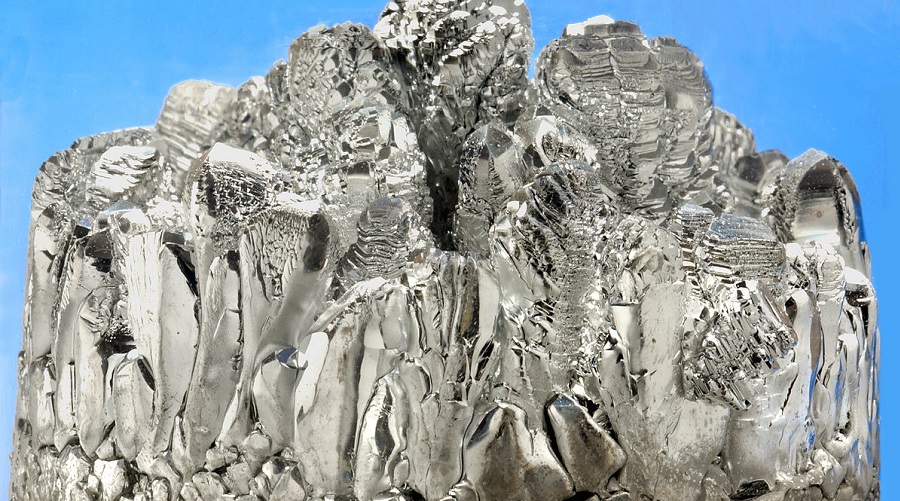Staff Writer | February 16, 2023 |

Crystalized magnesium. (Reference image by CSIRO, Wikimedia Commons).
A research team at the Tokyo University of Science has achieved some success in its search for new cathode materials for magnesium batteries.

In particular, the researchers are focusing on ways to improve the performance of cathode materials based on the magnesium-vanadium system.
In a paper published in the Journal of Electroanalytical Chemistry, the group explains that they worked with the Mg1.33V1.67O4 system but substituted some amount of vanadium with manganese, obtaining materials with the formula Mg1.33V1.67−xMnxO4, where x goes from 0.1 to 0.4. While this system offered high theoretical capacity, more details about its structure, cyclability, and cathode performance needed to be analyzed to understand its practical utility.
Accordingly, the researchers studied the composition, crystal structure, electron distribution, and particle morphologies of Mg1.33V1.67−xMnxO4 compounds using X-ray diffraction and absorption, as well as transmission electron microscopy. The analyses showed that Mg1.33V1.67−xMnxO4 has a spinel structure with a remarkably uniform composition.
Next, they conducted a series of electrochemical measurements to evaluate the battery performance of Mg1.33V1.67−xMnxO4, using different electrolytes and testing the resulting charge/discharge properties at various temperatures.
The team observed a high discharge capacity for these cathode materials—especially Mg1.33V1.57Mn0.1O4—but it also varied significantly depending on the cycle number. To understand why this happened, they analyzed the local structure near the vanadium atoms in the material.
“It appears that the particularly stable crystal structure along with a large amount of charge compensation by vanadium leads to the superior charge/discharge properties we observed for Mg1.33V1.57Mn0.1O4,” lead researcher Yasushi Idemoto said in a media statement. “Taken together, our results indicate that Mg1.33V1.57Mn0.1O4 could be a good candidate cathode material for magnesium rechargeable batteries.”
Idemoto said that through future research and development, magnesium batteries could surpass lithium-ion batteries thanks to the former’s higher energy density.
The scientist pointed out that, in addition to the potential to realize higher battery capacities, magnesium is considered a promising candidate for rechargeable batteries because the metal is safer for battery chemistries than lithium and is more abundant.
Thus, his research aims to address the low voltage window that Mg ions provide, as well as the unreliable cycling performance observed in Mg battery materials.
South32 sees China manganese demand up as half-year profit falls
Reuters | February 16, 2023

Construction site in China (Stock Image)
Diversified miner South32 Ltd pointed on Thursday to signs of rising Chinese demand for steel-making material manganese, while reporting a 44% drop in first-half underlying earnings driven by inflation and falls in prices for its key commodities.

The result slightly beat analyst’s expectations.
The company, the world’s biggest producer of manganese, said the steel market in China had just begun to warm up following the end of pandemic controls there late last year. A pick-up in property-related steel demand from China would underpin higher manganese prices in coming months, chief executive Graham Kerr told Reuters.
“Real estate is probably still the sluggish market at the moment. That hasn’t quite taken off yet compared to the industrial side,” he said.
However, fresh buying of steel from that sector should erode stockpiles and help lift manganese prices to around $6.20 per dry metric tonne over the next three months from around $5.90 currently, he said. As more supply from South Africa appeared, prices would fall back towards $5.20 to $5.30, he said.
Headquartered in Perth, South32 was spun off from mining giant BHP Group in 2015. It also produces aluminum, lead, zinc, nickel and coking coal and copper.
Underlying earnings for the six months ended Dec. 31 were $560 million, compared with $1 billion a year earlier and ahead of a Visible Alpha consensus of $550 million.
South32 logged $127 million in cost rises linked to general inflation across its Australian, South African and Columbian operations.
Kerr said inflation was particularly acute in Australia’s labour market, where competition for highly paid workers such as jumbo drill operators was fierce. Lithium developments in Western Australia and mine-sustaining projects by iron ore majors were driving up demand for such workers.
Also, he said, some people no longer wanted fly-in, fly-out (FIFO) jobs, in which workers live at a mine for perhaps two weeks then go home for a week.
“That’s a function of a number of things: people coming out of Covid and making decisions around lifestyle. Some don’t want to do FIFO anymore,” he said.
“We are also losing some of our jumbo operators to places like Africa because they are chasing the dollars, so that’s the inflation driver.”
Kerr expects Australia’s labour market to stay tight for another 12 to 18 months.
The company expanded its capital management programme for the second half of its financial year by $50 million to $2.3 billion, leaving $158 million to be returned to shareholders by Sept. 1. It declared an interim dividend of 4.9 cents per share, down from 8.7 cents in the prior year and slightly below Citi’s expectation of 5.7 cents.
The shares closed 0.9% higher at A$4.66.
South32 separately said its vice-president of finance, Sandy Sibenaler, would become chief financial officer.
The company left its full-year 2023 production guidance unchanged.
(By Melanie Burton and Archishma Iyer; Editing by Shailesh Kuber and Bradley Perrett)
Reuters | February 16, 2023

Construction site in China (Stock Image)
Diversified miner South32 Ltd pointed on Thursday to signs of rising Chinese demand for steel-making material manganese, while reporting a 44% drop in first-half underlying earnings driven by inflation and falls in prices for its key commodities.

The result slightly beat analyst’s expectations.
The company, the world’s biggest producer of manganese, said the steel market in China had just begun to warm up following the end of pandemic controls there late last year. A pick-up in property-related steel demand from China would underpin higher manganese prices in coming months, chief executive Graham Kerr told Reuters.
“Real estate is probably still the sluggish market at the moment. That hasn’t quite taken off yet compared to the industrial side,” he said.
However, fresh buying of steel from that sector should erode stockpiles and help lift manganese prices to around $6.20 per dry metric tonne over the next three months from around $5.90 currently, he said. As more supply from South Africa appeared, prices would fall back towards $5.20 to $5.30, he said.
Headquartered in Perth, South32 was spun off from mining giant BHP Group in 2015. It also produces aluminum, lead, zinc, nickel and coking coal and copper.
Underlying earnings for the six months ended Dec. 31 were $560 million, compared with $1 billion a year earlier and ahead of a Visible Alpha consensus of $550 million.
South32 logged $127 million in cost rises linked to general inflation across its Australian, South African and Columbian operations.
Kerr said inflation was particularly acute in Australia’s labour market, where competition for highly paid workers such as jumbo drill operators was fierce. Lithium developments in Western Australia and mine-sustaining projects by iron ore majors were driving up demand for such workers.
Also, he said, some people no longer wanted fly-in, fly-out (FIFO) jobs, in which workers live at a mine for perhaps two weeks then go home for a week.
“That’s a function of a number of things: people coming out of Covid and making decisions around lifestyle. Some don’t want to do FIFO anymore,” he said.
“We are also losing some of our jumbo operators to places like Africa because they are chasing the dollars, so that’s the inflation driver.”
Kerr expects Australia’s labour market to stay tight for another 12 to 18 months.
The company expanded its capital management programme for the second half of its financial year by $50 million to $2.3 billion, leaving $158 million to be returned to shareholders by Sept. 1. It declared an interim dividend of 4.9 cents per share, down from 8.7 cents in the prior year and slightly below Citi’s expectation of 5.7 cents.
The shares closed 0.9% higher at A$4.66.
South32 separately said its vice-president of finance, Sandy Sibenaler, would become chief financial officer.
The company left its full-year 2023 production guidance unchanged.
(By Melanie Burton and Archishma Iyer; Editing by Shailesh Kuber and Bradley Perrett)
No comments:
Post a Comment